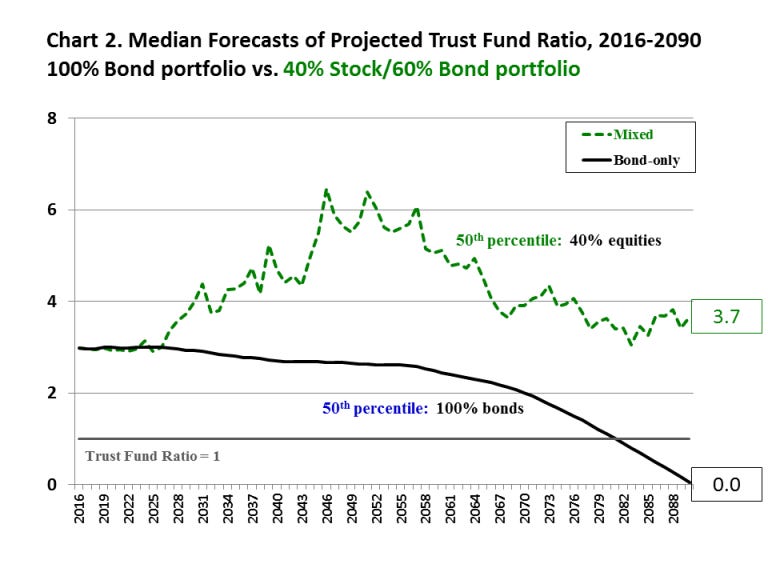As I noted in a previous post, the trustees of the Social Security Trust Fund issued their annual report, which predicted that the Trust Fund will run out of funds in 2033—just eight years away. When this occurs, social security payments will continue, but benefits would be reduced by 23% across the board unless Congress acts. This may actually be an optimist report. The assessment predicts that there will be an increase in the fertility rate, which many analysts think is unrealistic.
In my post, I noted that Congress would need to make some tough tax and benefit decisions to fix this shortfall.
In a Washington Post op-ed, Senators Tim Kaine and Bill Cassidy suggest another way to address this shortfall—by diversifying the investments held by the Social Security Fund. Right now the Fund invests only in Treasury bonds. The proposal is to supplement this with investments in stocks and other securities. I was skeptical at first, but there is analytical support for this approach.
The Senators propose creating an additional investment fund of $1.5 trillion— in parallel to the trust fund, not replacing it —that would be invested in a stocks, bonds and other investments that would generate a higher rate of return than Treasuries. Under their proposal, the U.S. Treasury would pay for any shortfalls in the Trust Fund for the next 75 years. At the end of 75 years, the investment fund would pay the Treasury back and fill the future Trust Fund gap. They estimate that there would be up to a 20 percent reduction in indebtedness.
Notably, any investment risk would be to the Trust Fund as a whole, not individual beneficiaries as was the case with a Social Security privatization proposal by President Bush. The program would remain a defined benefit program. As with the TSP (the federal retiree 401(k) program), the fund would have guardrails to ensure that the government was not exercising control over US companies—such as investing only in index funds.
Does this make sense? My take is that while this proposal may not be ”the” solution to Trust Fund shortfall, it offers an important additional tool to solving that shortfall—diversification of the Trust Fund investment.
The idea of diversification of Trust Fund assets is not new. The Chicago Federal Reserve Bank did an analysis of the impact of diversification of the Trust Fund in 1999 and concluded that “investing Social Security Trust funds in the stock market is an unqualified boon”, with the addition of stock investments adding ten years or more to the solvency of the Trust Fund.
The Brookings Institute analyzed the idea in 2016 and found that replacing the 100% bond investment portfolio with a conservative 40/60 stock and bond portfolio would indeed help address the problem. They analyzed what would happen if Congress increased the payroll tax by 2.62 percentage points in 2016 and then phased in equity investments over a 15 year period. They then ran a Monte Carlo simulation to take into account changes in market conditions.
As the chart below shows, they found that a diversified Trust Fund did much better over time as measured by the “Trust Fund ratio”—the amount of assets in the Trust Fund at the beginning of the year divided by expected Social Security payouts during the year:
Senators Kaine and Cassidy note another example as well. In 2001 Congress created the National Railroad Retirement Investment Trust, which is a diversified investment fund designed to fund pensions for railroad workers. It has been in the black for years.
While diversifying the Trust Fund certainly looks like an important contributor to making the Trust Fund solvent, we should be skeptical that it is the only thing we need to so. Notably, the Brookings analysis assumed a payroll tax increase. One major driver of the problem is demographics—we are living much longer than in the past and the ratio of workers (paying into the trust fund) to retirees (getting benefits out of the system) has gone from 5 to 1 in 1960 to 3 to 1 now, and is expected to go to 2 to 1 by 2035. The Kaine-Cassidy proposal does nothing to address the structural problem.
We certainly need to kick the tires on the assumptions in the analysis used to develop the Kaine-Cassidy proposal, but it offers a positive contribution to the development of a solution that would at least lessen the tax increases and benefit cuts otherwise needed to make the Trust Fund solvent.



